When I was a boy of about eight, I used to hunt deer out of a little 12x16 camp that sat up in a bowl on the top of Shatterack Mountain in Rupert, Vermont. My father and Junior Harwood had gone in together on the camp and the woodlot it sat on – 200 acres of northern hardwood forest on land vertical enough to make a mountain goat balk. The land was so steep that the first timber harvest was subbed out to an ambitious German logger who rigged a skyline cable and winched the logs out like an alpine gondolier; I’m told it was the first cable logging job ever undertaken in Bennington County.
The camp itself was of the most basic construction – 2x4 framing, half-inch plywood walls, rolled roofing – with the exception of a remarkable fieldstone chimney that dominated the south wall of the structure, the proverbial dress on a pig. To thwart porcupines, we wrapped the lower four feet of camp in aluminum printing sheets gleaned from the Bennington Banner newspaper. You can still read the news copy and note the clip art that was all the rage back in the late 1970s.
In those days, Dad and I would hunt the farm near home on opening day; then we’d head in to camp, where Junior and his son, Matt, my friend and schoolmate, would be waiting. Dinner was a simple but hearty affair: kielbasa, black coffee, and a heavy dose of something starchy; if we were lucky, we’d have medallions of fresh inner tenderloin from a tawny mountain buck.
Afterwards, when Matt and I had done the dishes and fetched fresh water from the spring, we’d retreat to our bunks and listen intently as Dad and Junior waxed poetically about men and deer and places they had known: Dad’s recollections of epic deer drives down in Walker Valley, where men just back from the war pushed whitetails with a soldier’s discipline; Junior’s tales of rogue bears, snarling bobcats, and magic buck deer that were the color of the wind.
Anyway, there was no booze in this camp, no girlie magazines. (I’d find those camps later in life.) My father and Junior were serious deer men who hunted with purpose. We rose at a quarter to four and were out the door well before the first hint of light smeared the eastern sky. In my memory, I can feel the warm camp air wilt against the pre-dawn frost. We are walking in darkness towards our hunting stands – leaves brittle underfoot, breath ragged, the gun heavy in my arms. Dad’s shape is climbing before me, up that ungodly steep mountain, and it seems as though we’re going to walk right into the stars.
Camps in Literature, Camps in Life
Hunting camp. It’s hard to imagine a more meticulously covered topic. Thousands of writers have tackled the subject in sporting magazines. Every cub reporter from every Podunk newspaper in the Northeast has written the obligatory deer-camp feature – and I count myself in that number. Aldo Leopold composed many of his most famous writings from his deer camp – nicknamed “The Shack.”
Perhaps the most famous writer to tackle the subject was William Faulkner, whose short story “The Bear” is about the rise and fall of a deer camp. Faulkner reportedly played hooky from the 1949 Nobel Prize presentation ceremony, where he was slated to receive the prize for literature, because he had prior commitments at deer camp. Legend – as reported in Robert Wagner’s book Deer Camps – has it that when asked what he’d do if the Swedish ambassador came to camp and handed him the prize money, Faulkner looked up from a sink-full of dirty dishes and exclaimed: “I’d tell him to put it on the table and grab a drying rag and pitch in.”
Read any literary take on deer camp and you’ll find the camp set in a sensual, often sacred, misty mountain landscape. This technique reflects the camp owner’s journey into camp as a pilgrimage into nature, into the landscape. The hunting camps scattered around the North Woods are as much a part of the forest landscape as the toadstools found splattered throughout a sugarbush.
Steve McLeod hunts out of two different camps in north-central Vermont. He says that while the focus of the camps is on hunting and fishing, members use the camps year-round for any number of outdoor excursions.
“Probably around 30 or 40 people use the camps annually for all sorts of things: snowmobile outings, snowshoeing, hiking, berry picking, just getting away,” said McLeod. “A hunting camp gives you a connection to the land, and as a result, not only do the sportsmen in the family become attached to all the sporting traditions, but the non-hunters become attached as well. The camp becomes a part of who the family is; it helps us all develop a love of nature and a rural lifestyle.”
McLeod speaks eloquently of a hunting camp’s ability to connect generations, families, and communities.
“Hunting camps tend to breed a continuity that other things don’t,” said McLeod. “The bonds and traditions of the camp grow as the life of the camp grows.”
McLeod says that a significant number of camps in northern Vermont are member camps, as opposed to single-family camps. These camps were built by buddies as a group and are used as a group pursuant to rules that are jointly developed. This membership structure can be as simple as a handshake and a passed hat or structured more formally, where the camp becomes its own corporate entity.
“What makes a member-camp work is the trust and good will of the members,” said McLeod.
Hunting camps come in all sizes and shapes. Camp could be a canvas tent five miles back in the wilderness or a two-story post-and-beam structure on 30 acres of suburban farmland. What makes it a camp is its primitive nature and simple spirit. Camps do not have electricity, telephones, or cable television. If they do, it’s not a camp; it’s a second home.
Beyond these atavistic threads common to all hunting camps, the nitty-gritty details of camp ownership are tied up in land-use issues that are much more current. How you own your camp, it turns out, is based largely on where you’re from.
Camp Leases
The simplest camp-ownership situation occurs when a landowner builds a camp on land they already own. But it’s not uncommon for camps to be built on land that somebody else owns, and hunting-camp lease deals, especially those involving timber companies or investment groups, vary throughout the North Country.
In New York state, a number of large landowners lease camps and allotments of property to hunters.
Dennis Aprill, of Schuyler Falls, New York, is one such hunter. Aprill hunts out of the Brow Hill Hunt Club, which sits on former International Paper (IP) lands on the back side of the Silver Lake Mountains in the eastern Adirondacks. When the club started in 1982, they leased about 3,000 acres from IP; over the years, as the per-acre cost went up, they leased less acreage. Today’s lease with the current owner, Lyme Timber, is for 878 acres. The hunt club has exclusive hunting rights to the parcel, and members usually post the land. “That’s how it’s done around here,” said Aprill. “You post your land and keep track of what goes on there. Your lease is your territory.”
Cotton-Hanlon, Inc., a timber management firm that owns 33,000 acres in western New York and northern Pennsylvania, has a similar lease program in place. In all, the company oversees about 250 hunting leases on its holdings. These leases run in size from 8 to 1,200 acres, averaging 80 to 100 acres.
Bob O’Brien, forester for Cotton-Hanlon, says that the hunting leases have come to represent an important revenue stream for the company. Hunters can lease as much or as little land as they want for an agreed-upon fee. The hunters may then erect a rustic camp on the parcel, post the land if they wish, and enjoy exclusive hunting rights to the property as if it were their own.
As land becomes more expensive to hold onto, landowners have begun to see hunting leases as a way of generating revenues beyond timber. “We started offering hunting leases in 1970,” said O’Brien, “but never really pushed them until property taxes went up.”
O’Brien says that, besides the revenue stream, camp leases offer large landowners a sense of security. “We own 33,000 acres of land that’s spread across two different states and 16 different counties. But we only have one and a half foresters on staff to cover this area,” said O’Brien. “Some of the guys who lease from us are out on the land every single weekend, so it’s a huge benefit for us to have extra sets of eyes and ears out there to let us know what’s going on.”
Exclusive hunting leases, such as Cotton-Hanlon’s, are becoming a more-common way to hunt in America. A study by the U.S. Fish and Wildlife Service found that money spent by hunters to lease land doubled between 1989 and 2000, to reach $625 million. Land-lease companies have sprung up nationwide to serve as a sort of matchmaker between hunters and property owners. Industry press releases suggest that the recreational lease industry is today approaching $1 billion annually.
Tom Dziekan, an affiliate for the Hunter’s Lease Network, oversees around 40 different hunting leases throughout New York state. He says that business has grown steadily in his four years with the company. “The landowners are becoming aware that this is a good way for them to generate money from their land,” said Dziekan.
While hunting leases remain relatively rare in parts of the Northeast, in southern and western parts of the country, the practice is common. “West of the Mississippi, if you’re going to hunt on private land, you need a lease,” said Dziekan.
Tom Brown, senior research associate leader at Cornell’s Human Dimensions Research Unit, an organization dedicated to studying human behavior associated with resource management, says that paid hunting leases in New York are still the exception to the general rule. Brown suspects that leases aren’t common in the Northeast because most landowners own relatively small parcels.
“By leasing land, landowners remove themselves from coverage by New York’s limited liability law,” said Brown. “Unless you’re a large corporation, it’s not really worth it financially” since you would need to purchase additional insurance.
New York, Vermont, Maine, and New Hampshire all have landowner-liability laws designed to absolve landowners of liability for any property damage or personal injury to a person who uses their property for recreation, providing an access fee is not charged. This legislation, which was first introduced by state legislatures in the 1950s and 1960s, specifies clearly that a visitor recreates on private land at their own risk. For example, when a visiting hunter was killed by a bull on a New York farm in the 1990s, the landowner was deemed protected from legal recourse by New York’s General Obligations Law.
Once landowners charge a fee to use their land, however, they’re no longer covered under this state-mandated legal framework. A landowner worried about litigation must then purchase liability insurance in the private marketplace. Dziekan says that the Hunting Lease Network carries a $2 million insurance policy to protect landowners and that this insurance is included in the lease price. Other hunting-lease companies offer similar packages.
New England Tradition
In northern New England, lease hunting is discouraged by state law. Maine specifically forbids charging a fee for access if the fee is directly related to the taking of game on the land (unless the land is an authorized commercial shooting area). In New Hampshire, landowners enrolled in the state’s current use program who do not post their property are eligible for a 20 percent reduction in their assessment. And in Vermont, you can’t enroll in the state’s Use Value Appraisal program if you charge or receive a hunting-lease fee.
These measures are derived from the long tradition in New England of the public having open access to private land. The traditional timber company camp lease in New England often provides just the postage-stamp sized lot the camp sits on, with the larger surrounding parcel remaining open to all the leaseholders and the general public.
Ed Pineau, 52, hunts out of a family camp on Moosehead Lake in Maine. Ed’s father purchased the original lease from Great Northern when he was an employee with the company. The lease was 20x20 feet at the time; it has since been expanded to 100x250.
“I think my father paid $100 back then for a year-to-year lease,” said Pineau. “We were permitted to cut three cords of wood a year. We had to build a road into the camp, which we accomplished with pick-up trucks, shovels, and young backs.”
The camp itself was built from a torn-down barn and part of the boiler house from an old paper mill. Great Northern eventually sold the land, at which point Ed was able to purchase outright the parcel of land beneath the camp. To get to camp, he still depends on a 45- or 50-mile logging road that runs through private land.
Pineau says that much of the deer-hunting culture in Maine is based on the concept of open land. “You can hunt on 10 million acres in the state of Maine thanks to the good will of the landowners here,” said Pineau. “And make sure you emphasize the ‘good will’ part.”
This public use of private land in Maine stands in sharp contrast to southern states such as Texas and Oklahoma, where, according to the Agricultural Market Resource Center, in some counties 80 percent of the total acreage is leased. Hunters must pay what is commonly referred to as a “trespass fee.”
“We have a guy from Texas who hunts out of our camp,” said Pineau. “The first time he hunted up here, he was dumbfounded that we could walk out of the camp and hunt wherever we wanted to.”
Pineau worries, though, that things may be changing in Maine. “Lease prices have gone up 600 to 700 percent here in the last five years, so I’m not sure what it’s going to be like in 20 years.”
Tom Doak, Executive Director of the Small Woodland Owner’s Association of Maine, also wonders how secure the open land tradition is in Maine.
“As land prices go up, as regulation goes up, some landowners are looking at other states and seeing the revenues that are generated by hunting leases,” said Doak. “Something like $300 to $400 million [is generated by] hunting revenues – hunting that occurs almost exclusively on private land – so yeah, some people are saying, ‘that’s great, but how about our share?’”
From the North Woods to the Catskills
When you really dig into the camp traditions across the North Country, you learn that while the ownership details differ, the structures and the stories are pretty much the same.
Paul Reynolds hunts out of a big A-frame 50 miles north of Bangor, Maine. The camp sits about 13 miles back in the woods. A group of 12 to 14 men who hunt out of the camp call themselves the Skulkers of Seboeis. The Skulkers have hunted these Maine woods since 1967.
“The land used to be good whitetail country, but it’s been over-cut,” said Reynolds, “Still, on the third week of November, we wouldn’t hunt anywhere else. Even though the deer hunting’s not what it used to be, we go for the camaraderie, the laughs.”
The camp features a fieldstone fireplace, an old-fashioned cookstove, a gun rack that holds 20 rifles, and a three-holer outhouse. Each year, deer season ends with a big game supper and an awards presentation, where, for instance, someone is named the Skulker in Perpetuity. At least one member is known for his eloquent recitals, by memory, of Robert Service’s famous Yukon poetry. (Wherever you’re from, if you’ve spent any time in a hunting camp, there’s a better-than-average chance you’ve heard of Sam McGee.)
Many hours to the south , about an hour and a half out of New York City in Callicoon, New York, Hillside Hunt Club sits on a hodgepodge of leased and private parcels that straddle 690 acres of overgrown Delaware River farm country. Geographically, this seems like a world away from the Maine timberlands, and yet the motivations that club president John Miller speaks of – the camaraderie, the folklore, the connection to the land – are exactly the same.
“This part of the Delaware River still remains exactly how God made it,” said Miller.
Miller got around to talking about deer hunting, but only after he affectionately described the rolling topography of the land, the trout that haunt deep pools in the river, and the 9/11 memorial the group constructed at the land’s highest point.
“Believe it or not, my goal at camp is not to shoot a buck,” said Miller. “The biggest thing I look forward to on opening weekend is Mrs. O’Neill’s turkey dinner.”
This differed slightly from Ed Pineau’s stated deer camp goal of beating Lester, the camp’s patriarch, at cribbage, but in any case, you get the idea. The hunting is important, but camp itself, and the bonds formed therein, even more so.
And so it is with generations worth of history and lore, that hunters throughout the North Country depart for deer camp this fall. You’ll see them out on the highway, pickups piled high with gear, directional signals pointing toward some ribbon of road that runs into the hills.
Once in camp, they’ll turn on the propane, fetch water from the brook, kindle a fire in the camp’s stove. After the cold, stale air is driven from the camp, they’ll claim a favorite bunk, stow their gear, and set dinner to braise on the stove. The boys will be arriving then; warm greetings and cold whisky to follow. The next morning’s hunt will be discussed in intimate detail, then rehashed throughout a sleepless night.
Before bed, right after cards, the boys will tell stories. Not the macho hunting stories of Ernest Hemingway or Jim Corbett, but poem-like stories – tales that tease out the history of the landscape, of men and mountains and animals who run wild through the gloaming. Stories about Junior Harwood, forever young, with his packbasket and red flannel. Stories where boys follow their dads up Shatterack Mountain to hunt buck deer the color of the wind.


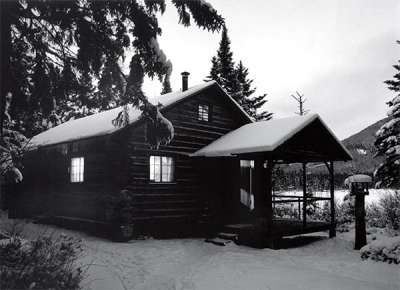
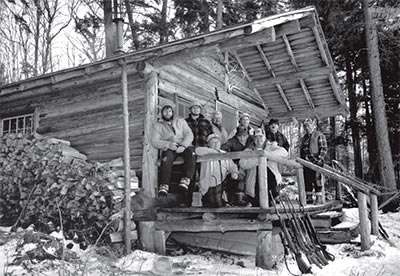
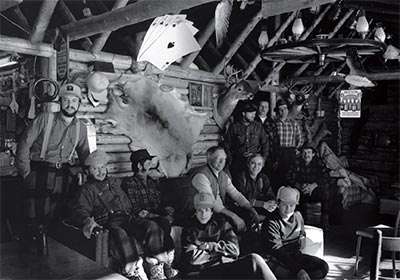
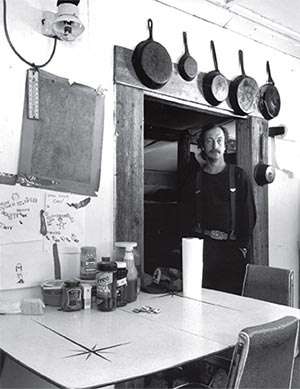
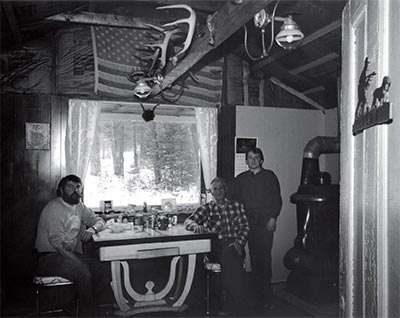
Discussion *